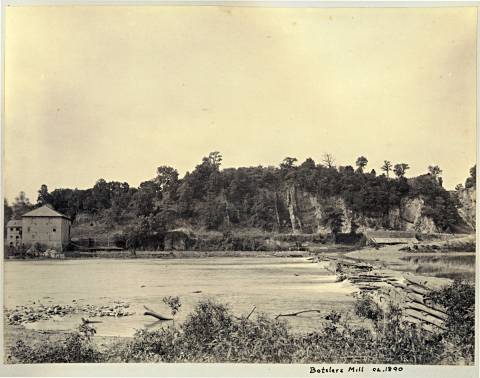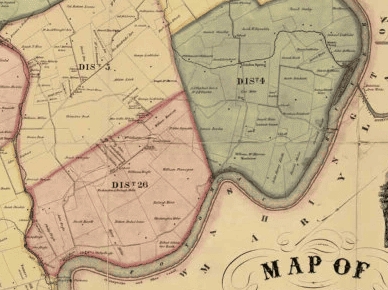Without the Irish, there would be no Catholic congregation in Harpers Ferry. Though St. Peter’s is recognized today as a Roman Catholic parish, its foundations and identity were distinctly shaped by its overwhelmingly Irish congregation. Historically, its sermons and traditions reflected a Celtic-rooted version of the faith that Irish immigrants had carried with them across the Atlantic. After its construction, St. Peter’s Church became a Catholic sanctuary molded by and for Irish laborers in a Protestant town.
Early Catholicism in Harpers Ferry
Prior to 1820, Harpers Ferry had only a small Catholic presence, limited largely to indentured laborers working for enterprises such as George Washington’s Patowmack Company. With the launch of large-scale construction efforts in the 1820s, the Catholic population in and around Harpers Ferry expanded rapidly, driven predominantly by the influx of Irish immigrant laborers needed to build infrastructure projects.
Before the construction of a Catholic church in Harpers Ferry, Catholic residents and passing laborers relied on an informal and often inconsistent pastoral network. In the absence of a local church, priests from Conewago, Pennsylvania, and Frederick, Maryland, traveled large distances along routes like the Great Wagon Road and Monocacy Road to serve the quickly growing Catholic population.
Between the time of the Revolutionary War and the year 1800, the first Catholic Church in Virginia was rudimentarily constructed in Shepherdstown. It is likely this building resembled more of a log cabin than a modern-day church. Father Gallitzin is known to have held mass there periodically for Irish laborers, however the church was abandoned sometime prior to 1820. From 1825 to 1830, the closest Catholic church was in Martinsburg, of which 

According to the records of St. James Parish, the first priest to minister in the Harpers Ferry area was Father John Dubois, a French immigrant who had begun his missionary work in Norfolk, Virginia, before moving into the valley around 1792. Additional priests from Hagerstown, Maryland, also occasionally tended to the community, though their visits were far more sporadic.
By 1830, the Diocese of Richmond could no longer ignore the rapidly growing Catholic presence in the Harpers Ferry area. Most Irish Catholic families did not live within the town limits of Harpers Ferry. Instead, they were spread out along the banks of the river. Large numbers of Irish lived from Bolivar to Oak Grove and from Sandy Hook to Dargan, Maryland, forming tight-knit communities spanning both banks of the Potomac. Residents in these areas made the trip into Harpers Ferry on Holy days along the rough roadways following the river. Both the size and devotion of this surrounding population pushed the Diocese of Richmond to recognize the need for a central, permanent spiritual home.
Construction of the Church
In his will, Robert Harper directed that four acres of his property was to be set aside for the construction of a church. Carefully following his directives, descendants James, Gerard, and Sarah Wager promised land to the Diocese to erect a church. On October 15, 1830, construction of Harpers Ferry’s first Catholic Church officially began with the laying of a cornerstone by Reverend Gildea. As the deed transfer was not completed until May 10, 1831, it is likely the descendants wanted to see progress on the church prior to their donation. Both will and deed are on file at the Jefferson County Courthouse and have also been transcribed.
The church was completed in the spring of 1833, largely utilizing funding collected from Irish laborers and local residents and supported by fundraising calls in the Virginia Free Press. John Tearney, an Irish stonemason and Harpers Ferry resident, oversaw the church’s construction. The bulk of Tearney’s workforce was made up of Irish canal workers who donated their off-time, working without payment so that they might have a proper place of worship.
The new Catholic Church at Harpers-Ferry, was consecrated, on Sunday last, by Archbishop WRITEFIELD of Baltimore, aided by the Rev. Mr. GILDEA, and two other clergymen from Maryland. Indisposition prevented us from witnessing the ceremony, but we learn that it was interesting and imposing. The Church is a very neat edifice, built upon ground given by the Wager family. It does great credit to the indefatigable Pastor, under whose auspices it was commenced and finished, and to the community who contributed to its erection.– It stands upon the western hill, and adds much to the village by way of ornament.
Although St. Peter's is credited as being the first Catholic chapel constructed in Harpers Ferry, an earlier attempt was constructed along Shenandoah Street. This building was a small, log structure that quickly succumbed to flooding in the 1820s. From existing records, I am personally of the belief that this was not a church, but a multi-use building where mass was consistently held.
St. Peter's was the third church constructed in Harpers Ferry and the only one that was not erected on government-owned land. Both the Free Church, built in 1825, and the Methodist Episcopal Church, constructed in 1828, served Protestant congregations. The explosive growth of the Catholic population and the construction of a Catholic church through such grassroots efforts can almost wholly be credited to Harpers Ferry’s Irish Catholic laborers.
Modest but stately, the original church was constructed in a Neo-Gothic style, standing 39 feet wide, 75 feet long, and 25 feet high to the eaves. It was a brick building erected on a stone foundation with a wooden steeple. The interior of the church boasted beautiful, vaulted ceilings, a marble pulpit, and an impressive image of the Virgin Mary holding the Infant Jesus.

The Influence of Erin
Once completed, the church was served by predominantly Irish clergy. This likely contributed to its powerful and lasting influence on the surrounding Irish Catholic community.
The people who filled the pews were already deeply devout, but hearing the teachings of the Church delivered from one Irishman to another surely deepened their connection to the parish. As misunderstood as the Irish felt in everyday life, a priest who understood and shared their struggles, culture, and viewpoints could do nothing but deepen the Irish community's loyalty to the Catholic Church.
The priests of St. Peter's not only delivered sermons but also perfectly reflected the very identity of their congregants, reinforcing the moral values, customs, and faith traditions they had carried from Ireland. Like much of their congregation, many priests had family members who remained in Ireland.
Thus, the church was not only sympathetic to the cause of Irish freedom, but also had a heavy-handed influence on the culture and politics of its Irish congregation in Harpers Ferry and the surrounding countryside.
The large congregation of St. Peter's Church was largely made up of Irish Catholic families, and to a far lesser extent, Italian families. On Sundays, two masses were held in order to accommodate all congregants.
In 1860, Father Michael Costello writes that out of a population of 4,000 in the town of Harpers Ferry, about 700 residents are members of his congregation. According to his writings, Catholics made up an average of 20% of the population of Harpers Ferry.
At Harper's Ferry, where I principally reside, I have a very pretty little church, capable of holding between 400 and 500 persons; and, as it is too small to hold all the congregations at the same time, I have leave to say two Masses on Sundays. The church is literally built upon a rock, and it is one of the first things that strike the visitor's view as he approaches the town. [...] The population is about 4000. Of this number there are between six and seven hundred Catholics. [...]
Beyond its role as a house of worship, St. Peter's Church served as a social and moral pillar. In 1843, the Catholic Total Abstinence Society of Harpers Ferry was established in association with the church, with the primary objectives of promoting temperance and personal discipline within the Irish working-class community.
This temperance movement within the confines of St. Peter’s Church was likely a result of a mixture of a larger push for temperance by Father Theobald Mathew in Ireland and the nativist sentiment that Irish drinking was a threat to the new nation. Remarkably, the society reported 383 members in their first year; the church’s message was beginning to take root in community life.
By the mid-19th century, St. Peter’s wasn’t simply a place of worship. It was a spiritual and cultural center for people who had long lived on the margins, in Ireland, along the infrastructure lines, and now within Harpers Ferry. It offered not only the promise of salvation, but also stability, dignity, and community. For Jefferson County, the church offered Irish residents a center to worship, marry, celebrate births, mourn the deceased, and build relationships among themselves and the outside world.
Expansion & Renovations
The 2nd of July was an eventful day to the Catholics of Harper’s Ferry. Father O’Farrell, of Petersburg, said the last mass in St. Peter’s Church, which has stood like a sentinel guarding the village for over 65 years– b[r]aving tempests, and the shot and shell that were hurled against it during the war. To Rev. M. A. Costello, D. D., now deceased, is due the preservation of the church, for he remained to guard it when Bishop McGill, the Bishop of Richmond, offered him an opportunity to go to Ireland, his native land, but he refused to leave and died at his post, and now lies in our church yard, awaiting his call to Judgement. Many eminent priests have served as pastors. Among those most prominent are numbered Archbishop Kain, of St. Louis, and Bishop Van de Vyver, of Richmond.– The church was built by Rev. John Golden in 1830– corner stone being laid on the 25th of October of that year. It was dedicated on St. Patrick’s day, 1832. Among those who officiated at the last services held in the church were Fathers Bowler and Wilson, and Rev. Lawrence Kelly, the present pastor. Fathers O’Farrell and Bowler are both natives of the parish and said their first masses on the same altar they offered the last one they will ever celebrate in the old church. The last benediction was given by Father Bowler. A most eloquent and affecting sermon was delivered by Father O’Farrell. Many tears were shed when he bade farewell forever to the old landmark and dear church, which for over 65 years has done its work so nobly. The new church will be erected as soon as possible and will be of gothic architecture and of Indiana greystone.

As the parish grew, its campus did too. A two-story stone rectory was built in 1853. Following, the church constructed a Catholic schoolhouse between 1854 and 1857 on a parcel leased from the federal government. This school served both Catholic and non-Catholic children in the area until about 1886, when it was converted into what is now the existing rectory.
A second schoolhouse was later constructed on Shenandoah Street, continuing the church’s educational mission. This schoolhouse was operated until 1899, when a dwindling population of students forced its closure.
In 1896, the original church underwent an extensive transformation. A larger and more elaborate building was erected on the original foundation. While much of the original structure was replaced, key materials were incorporated into the new edifice, and the cornerstone laid by Reverend Gildea was preserved and repositioned.
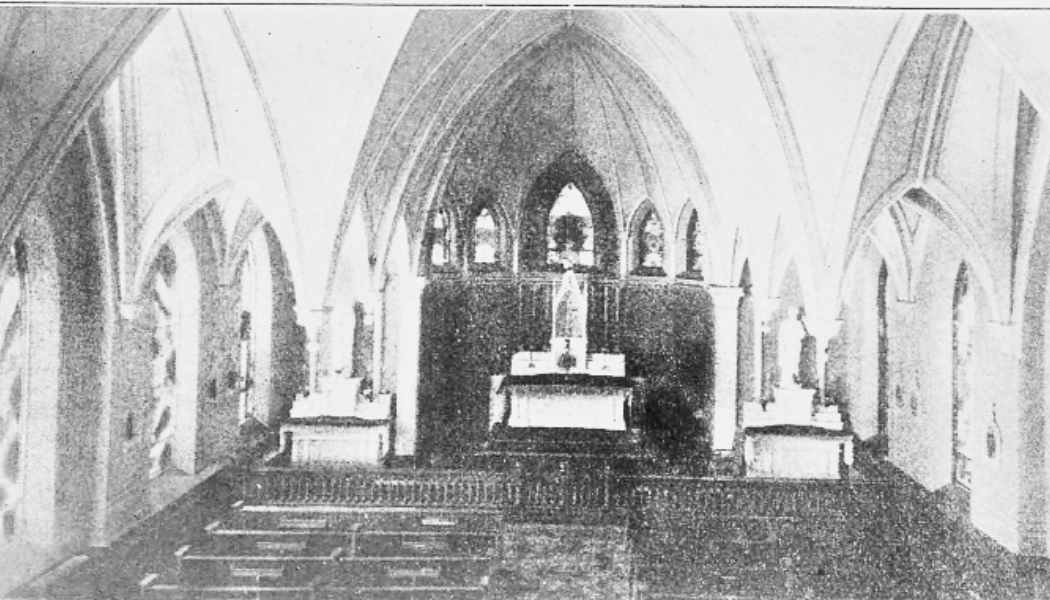
The interior of the church also underwent a significant four-month renovation in 1909, during which time mass was held in the parish schoolhouse. In a subtle nod to its Irish roots and culture, the interior was finished in a green, amber, and gold color scheme.
Large memorial stained glass windows were purchased by members of the congregation, and sizable marble statues of the Virgin Mary and Joseph, gifted by parishioners, flanked the altar. The altar was refitted with a velvet carpet and brass.
Father Costello & The Civil War
The story of Father Michael Costello saving the parish from destruction during the American Civil War by choosing to fly a Union Jack flag above the church is a well-known and repeated story that does not bear repeating here.
However, one important aspect of this story that is repeatedly overlooked is the tumultuous history of Ireland, England, and the Union Jack flag. To the Irish people, specifically Catholics, the Union Jack flag was a symbol of a painful British rule that stripped them of all rights and dignity and reduced them to unimaginable poverty.
For an Irishman during this period of painful British rule in his homeland, it was probably extremely difficult for him to raise this flag above his church. Furthermore, it was probably very painful for his overwhelmingly Irish congregation to see this flag raised over their house of worship. I would imagine that this controversial act would have caused a very heated discussion between Father Costello and his congregation; with many family members of the congregation remaining in Ireland, it probably landed many men and women in confession.
Regardless of the tension and feelings this act probably brought his congregation, this move was undeniably an act of intelligence. Harpers Ferry changed hands 14 times during the Civil War. Because of Father Costello’s actions, the church was able to escape the conflict largely unscathed.
The Priests of Harpers Ferry

Rev. Demetrius Augustine Gallitzin

Rev. John B. Gildea

Rev. Richard Vincent Whelan

Rev. John Joseph Kain

Rev. Michael A. Costello

Rev. Augustine Van DeVyver
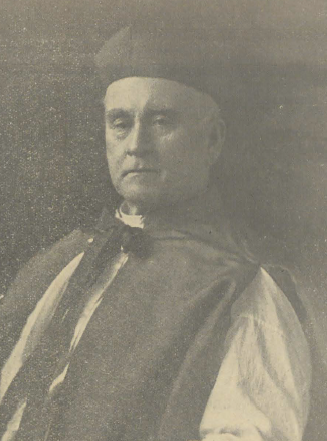
Rev. James T. O'Farrell
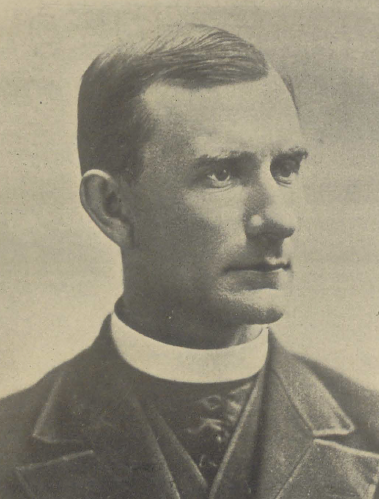
Rev. John W. Lynch
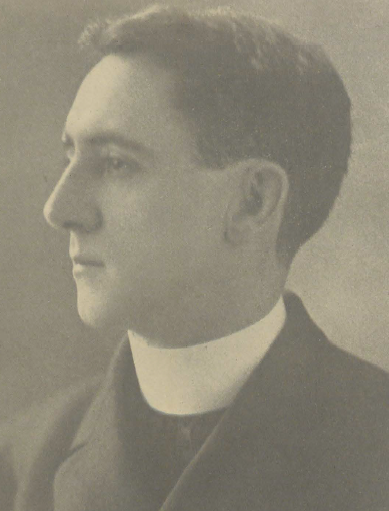
Rev. John A. Curran

Rev. Edward Tearney
| Years | Name |
|---|---|
| 1787 | Rev. Demetrius Galitzin |
| 1828-1834 | Rev. John B. Gildea* |
| 1834-1841 | Rev. Richard Vincent Whelan |
| 1841-1844 | Rev. John O'Brien |
| 1845-1850 | Rev. Joseph Plunkett |
| 2 years | Rev. John Kenny |
| 1850-1857 | Rev. Andrew Talty |
| 1857-67 | Rev. Michael A. Costello* |
| 1867-75 | Rev. John Joseph Kain* |
| 1875-81 | Rev. Augustine Van DeVyver |
| 1881-83 | Rev. James B. O'Reilly |
| 1883-84 | Rev. John L. Tiernan |
| 1884-92 | Rev. Thomas J. Wilson* |
| 1892-1894 | Rev. Michael F. Dinneen |
| Years | Name |
|---|---|
| 1894-98 | Rev. Lawrence Kelly |
| 1898-99 | Rev. Edward J. Walsh |
| 1899-02 | Rev. John J. Massey |
| 1902-10 | Rev. James E. Collins |
| 1910-12 | Rev. John W. Lynch |
| 1911-12 | Rev. F. Joseph Magri* |
| 1913-14 | Rev. James Gilsenan |
| 1914-30 | Rev. John A. Curran |
| 1930-? | Rev. Edward Vincent Mullarkey |
| 1930's | Rev. John Cannon |
| mid-1930's | Rev. Thomas Healy |
| 1952-67 | Rev. Joseph Ryan |
| 1967-80 | Rev. Lambert Stack |
| 1967-80 | Rev. Cyril Driana |
Other Priests of Interest
T he following priests were known to have held mass at least once in St. Peters Church, however they were only temporarily filling in for the Parish Priest:
| Rev. Thomas Becker | Rev. John Florid | Rev. DuHamille |
| Rev. ? Leonard | Rev. John Mahoney | Rev. McElroy |
| Rev. ? Redmond | Rev. Patrick H. Donahue | Rev. Hugh J. McKeefry |
| Rev. Edward M. Tearney | Rev. John J. Bowler | Rev. Michael J. Keyes |
| Rev. James T. O'Farrell | Rev. James Brady | Rev. Oscar Sears |
What happened to the record books of St. Peter's Church?

St. James Catholic Church of Charles Town now operates both St. Peter's Church and cemetery. The grounds upon which St. Peter's Church sits are now owned by the park service.
St. James Catholic Church in Charles Town, West Virginia now holds all of the original records from St. Peter's Church.
Unfortunately, a burglary in the rectory of St. Peter's occurred during the evening of October 31, 1956. The only item stolen was the combined marriage-baptismal record book of November 5, 1857, to December 31, 1913.
The stolen register has been partially restored using marriage licenses and family records; however, it is not complete. Burial records are not known to exist.
While St. James' records are closed, volunteers will perform look ups. Donations to the church are gratefully accepted for their service.


